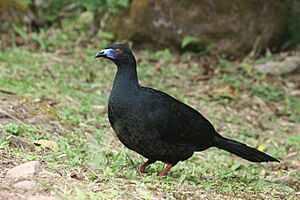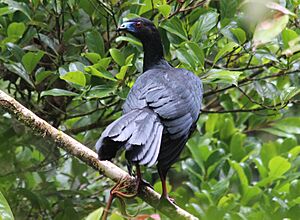Black guan facts for kids
Quick facts for kids Black guan |
|
|---|---|
 |
|
| Conservation status | |
| Scientific classification | |
| Genus: |
Chamaepetes
|
| Species: |
unicolor
|
 |
|
The black guan (Chamaepetes unicolor) is a cool bird that belongs to a family called Cracidae. This family includes birds like chachalacas, guans, and curassows. You can find the black guan living in the beautiful countries of Costa Rica and Panama.
Contents
What is a Black Guan?
Its Family Tree
The black guan is part of the Chamaepetes group of birds. Its closest relative is the sickle-winged guan, which lives in South America. Scientists group animals like this to understand how they are related.
What Does a Black Guan Look Like?
The black guan is a medium-sized bird. It is about 62 to 69 centimeters (24 to 27 inches) long. It weighs around 1135 grams (2.5 pounds).
Adult black guans are completely black. They have bright blue skin around their red eyes. Their legs and feet are a pretty pinkish-red color. Young black guans look similar. However, they are not as shiny and have browner feathers on their underside. Their facial skin is also dark brown or black.
Where Do Black Guans Live?
Their Home and Habitat
You can find the black guan in Costa Rica and Panama. They live in a special type of forest called a cloudforest. These forests are often covered in clouds and mist.
Black guans prefer steep areas in these forests. They usually live at high elevations. This is typically between 1000 and 2250 meters (3,280 to 7,380 feet) above sea level. Sometimes, they can be found as low as 800 meters (2,620 feet). Other times, they live as high as 3000 meters (9,840 feet).
How Do Black Guans Behave?
Moving Around
Scientists believe that black guans mostly stay in one place. They do not travel far. However, there is some evidence that they might move to different elevations depending on the season.
What Do They Eat?
Black guans usually look for food alone or in small groups. They love to eat fruits! Studies in Costa Rica have shown they eat at least 35 different kinds of fruit. They mostly eat fruit from trees. But they will also eat fruit that has fallen to the ground.
How Do They Raise Their Young?
The breeding season for black guans is thought to be from February to June. Only one nest has been described by scientists. It was a small platform made of twigs and leaves. The nest was placed in a clump of epiphytes in a tree. It was about 4.5 meters (15 feet) above the ground. Female black guans usually lay two or three eggs.
What Sounds Do They Make?
Black guans make different sounds. During the breeding season, they make piping calls. If they are disturbed, they might make a low, deep "ro-rooo" sound. They also have an alarm call that sounds like "tsik tsik...". At dawn and dusk, they perform a loud, sharp, crackling wing-rattling display. This is when they make noise with their wings.
Are Black Guans Safe?
Their Conservation Status
The IUCN (International Union for Conservation of Nature) has said that the black guan is a species of "Least Concern." This means they are not currently in danger of disappearing.
In Costa Rica, you can find many black guans in protected areas. In Panama, they are also quite common in some places. However, even in protected areas, people sometimes hunt them for food.



